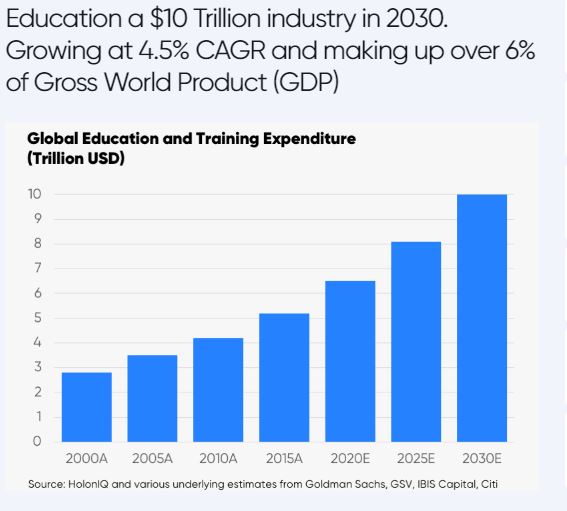In 2025, personalization will be key to effective education marketing strategies. Using data analytics tools to understand your audience allows for more targeted, relevant communication.
![Higher Education Marketing 2023 and Beyond [Detailed Analysis], Higher Education Marketing, Education Marketing, Education PR, Digital PR, Public Relations, Digital Marketing, social media, SEO for Higher Education, Digital Marketing for Higher Education](https://firdoshkhan.in/wp-content/uploads/2022/11/Higher-Education-Marketing-Strategies.jpg)
Three years ago, I consulted with a prestigious private school that had been a community staple for over 50 years. Despite its long-standing reputation, they were facing a modern dilemma.
Enrollment numbers were declining, and their attempts to reach prospective students and parents were falling flat. The principal expressed deep concern: “We used to have waiting lists, but now it feels like we’re invisible online.”
I dug deeper into their marketing efforts. While they had some traditional methods in place print ads in local papers, brochures handed out at events it became clear that they were lacking a solid digital presence.
Worse, they weren’t engaging with the modern, tech-savvy parents who sought information about schools online.
That’s when we set to work, creating a marketing plan that transformed their approach, leveraging digital tools, SEO, and data-driven strategies.

By the next academic year, the school had not only reversed the trend of declining enrollment but had also cultivated a strong digital presence that boosted their reputation.
This story, while unique, is increasingly common as schools navigate the competitive educational landscape of 2025.
With shifting student demographics, growing reliance on technology, and the need for a robust online presence, schools must develop comprehensive marketing strategies that address these realities.
The Importance of Marketing in 2025
As we move towards 2025, the educational landscape is rapidly evolving. Schools can no longer rely solely on traditional methods to attract students and engage with parents.

Digital transformation is no longer an option but a necessity.
According to a recent report by Statista, global digital advertising spending is projected to surpass $700 billion by 2025, a clear indication that digital marketing is dominating across industries, including education.
For schools, this means shifting focus towards education digital marketing strategies that prioritize online engagement, personalized communication, and data-driven decisions.
Parents and students now expect schools to provide an immersive digital experience, from informative websites to interactive social media platforms.
This shift also opens up opportunities for schools to differentiate themselves and build strong connections with prospective families.
Step 1: Define Clear Marketing Objectives
The first step in building an effective marketing plan is to set clear, measurable objectives.

Without well-defined goals, it’s impossible to track progress or assess the effectiveness of your strategies. Based on my experience, schools that align their marketing goals with the following SMART framework are better positioned to achieve tangible results:
- Specific: Focus on clear, actionable goals, such as increasing website traffic by 25% or boosting social media engagement by 15%.
- Measurable: Set metrics that can be tracked, like inquiries, applications, or event attendance.
- Achievable: Goals should be realistic and attainable with the resources available.
- Relevant: Ensure that objectives align with your school’s overall vision, such as enhancing your academic reputation or boosting community involvement.
- Time-bound: Set deadlines for achieving goals, such as improving open house attendance within six months.
For example, when I worked with a local academy, our primary goal was to increase the number of inquiries through their website. We set a measurable goal of boosting inquiries by 20% over the next 12 months and monitored progress monthly.
This focus helped us optimize their digital marketing efforts and ultimately reach the goal ahead of schedule.
Step 2: Understanding Your Target Audience
Every school has a unique community, and understanding that community is essential. The most successful education marketing strategies are built on a deep understanding of your audience.

This involves segmenting your audience into categories like:
- Prospective Students and Parents: What are their primary concerns? Academic excellence, extracurricular activities, or a welcoming school culture?
- Alumni: Engaging alumni can enhance reputation and encourage word-of-mouth marketing.
- Local Community and Businesses: Building partnerships can provide added value, such as internships and sponsorships.
By understanding these different segments, you can tailor your digital marketing for education efforts to each group’s unique needs.
Data analytics tools can help track user behavior on your website, providing insights into what information is most relevant to each audience.
For instance, prospective parents may be most interested in school rankings, while students might focus on extracurricular offerings and student life.
Step 3: Build a Strong Digital Presence
Today, a school’s digital presence is its first impression.

In fact, 85% of parents and students begin their school search online, according to a National Center for Education Statistics report.
To stay competitive in 2025, schools must invest in a comprehensive digital marketing strategy that includes:
- An Up-to-Date, User-Friendly Website: Your school’s website should be intuitive, mobile-responsive, and showcase essential information such as academic programs, faculty profiles, campus life, and admissions details.
- Search Engine Optimization (SEO): Effective SEO ensures that your school appears at the top of search engine results when prospective families are looking for educational options. Schools that fail to invest in SEO risk losing visibility and traffic.
- Social Media Engagement: Platforms like Facebook, Instagram, and TikTok are essential for engaging with students, parents, and the broader community. By regularly posting student testimonials, events, and achievements, schools can create a strong online presence that builds trust.
A client I worked with struggled with a dated website that was hard to navigate. After we redesigned the site to be mobile-friendly and integrated SEO practices, the school saw a 35% increase in inquiries within six months.
Investing in your digital presence pays off significantly.
Step 4: Crafting a Content Marketing Strategy
Content is the driving force behind engagement. Schools must provide valuable, informative, and engaging content that resonates with their audience.
![Higher Education Marketing 2023 and Beyond [Detailed Analysis], Higher Education Marketing, Education Marketing, Education PR, Digital PR, Public Relations, Digital Marketing, social media, SEO for Higher Education, Digital Marketing for Higher Education](https://firdoshkhan.in/wp-content/uploads/2022/11/Higher-Education-Marketing.jpg)
A strong education marketing strategy includes:
- Blog Posts: Write about topics that matter to your community, such as educational trends, student achievements, and upcoming events.
- Videos: Video content, including virtual campus tours, student testimonials, and event highlights, is becoming increasingly popular. According to a HubSpot report, 72% of students prefer video over text when learning about a school.
- Social Media Posts: Consistent social media content, including updates, achievements, and interactive polls, encourages engagement and builds a loyal following.
- Email Newsletters: Personalize newsletters for parents, prospective students, and alumni to keep them updated on school events and achievements.
Regularly updating your content and keeping it aligned with SEO practices will improve visibility and attract organic traffic to your school’s website.
Step 5: Personalization Through Data Analytics
In 2025, personalization will be key to effective education marketing strategies. Using data analytics tools to understand your audience allows for more targeted, relevant communication.
![Higher Education Marketing 2023 and Beyond [Detailed Analysis], Higher Education Marketing, Education Marketing, Education PR, Digital PR, Public Relations, Digital Marketing, social media, SEO for Higher Education, Digital Marketing for Higher Education](https://firdoshkhan.in/wp-content/uploads/2022/11/Facebook-Ads-Metrics.jpg)
For instance:
- Segmented Email Campaigns: Send personalized emails to parents of prospective students, current students, and alumni. Tailor the messaging to address their unique interests and concerns.
- Personalized Website Content: Use dynamic website features to display content that is most relevant to each visitor. For example, a prospective parent might see information about admissions and tuition, while a current student could be shown upcoming school events.
- Targeted Advertising: Digital marketing platforms like Google Ads and Facebook Ads allow schools to target specific demographics, ensuring that your message reaches the right audience.
One of the schools I worked with used data analytics to track parent behavior on their website.
We discovered that parents were most engaged with content about academic outcomes and faculty credentials.
Armed with this insight, we tailored their messaging to emphasize these strengths, leading to a 20% increase in admissions inquiries within a year.
Step 6: Use Video and Virtual Tours
Video content will dominate the digital space in 2025. Schools should invest in producing high-quality video content that showcases their culture, achievements, and campus life.

Examples of effective video content include:
- Virtual Campus Tours: For families who cannot visit in person, virtual tours offer an immersive experience. This is particularly valuable for international students and those unable to attend open days.
- Student and Parent Testimonials: Authentic testimonials provide a personal touch and can be more persuasive than written testimonials. A 2023 survey found that 85% of prospective students trust video testimonials more than traditional marketing materials.
- Event Highlights: Capturing key events like graduation ceremonies, sporting events, or academic competitions provides insights into the vibrant school community.
Step 7: Building a Strong Brand Identity
In an increasingly competitive environment, schools need to build a strong and consistent brand. This includes creating a unified visual identity (logos, colors, and tone of voice) across all platforms.

A clear brand identity conveys professionalism and builds trust with prospective families.
A school’s brand should reflect its core values and strengths, such as academic excellence, diversity, community involvement, or innovative teaching methods.
The goal is to create a memorable and recognizable brand that differentiates the school from competitors.
Step 8: Focus on Sustainability and Social Responsibility
With growing interest in sustainability, schools can attract environmentally-conscious families by highlighting their commitment to green practices.

Sustainability and social responsibility are more than just trends they are values that resonate with modern families.
Schools can promote their efforts in:
- Reducing waste and promoting recycling.
- Participating in community service initiatives.
- Using sustainable resources in construction and operations.
Step 9: Embrace Hybrid and Flexible Learning Models
Post-pandemic, hybrid and flexible learning models are becoming the norm.

Schools should market their ability to adapt and offer flexible educational experiences, whether through online courses, hybrid learning programs, or personalized education paths.
Embracing these models not only appeals to students looking for adaptability but also demonstrates a school’s forward-thinking approach to education.
In fact, according to a report by HolonIQ, the global online education market is projected to surpass $350 billion by 2025, with hybrid models playing a critical role in this growth.
Schools that offer flexible learning options can attract a wider demographic, including students who prefer online courses, international students who may be unable to attend in person, and working students who need a more adaptable schedule.
To successfully market these programs, schools should:
- Highlight Flexibility in Promotional Materials: Emphasize the ease and convenience of hybrid learning in marketing materials, such as brochures, websites, and videos.
- Offer Virtual Open Days: Invite prospective students to participate in virtual open days to showcase the flexibility and adaptability of your school’s programs.
- Share Success Stories: Highlight successful students who have thrived in your flexible learning environment, particularly those who have balanced work or other commitments while pursuing their education.
Step 10: Prioritizing Wellbeing and Mental Health
In 2025, schools that prioritize student wellbeing and mental health will have a significant competitive edge.

With growing awareness of the importance of mental health, parents and students alike are placing increased emphasis on schools that offer comprehensive support services.
A 2023 study by the National Alliance on Mental Illness (NAMI) revealed that 1 in 5 students experience mental health challenges, making this a top priority for families.
Schools can incorporate mental health into their education marketing strategies by:
- Showcasing Wellbeing Programs: Highlight the availability of counseling services, wellbeing initiatives, and mental health support as part of the school’s broader commitment to student development.
- Promoting a Supportive School Culture: Use testimonials from students and parents who have benefited from your school’s mental health programs. Authentic stories are powerful tools for building trust with prospective families.
- Organizing Mental Health Awareness Campaigns: Schools can hold events or campaigns that raise awareness about mental health, positioning themselves as advocates for student wellbeing.
Marketing these initiatives not only demonstrates a school’s commitment to the holistic development of its students but also helps attract families who place a premium on mental health and emotional support.
Step 11: Monitor, Evaluate, and Adjust Your Strategy
No marketing plan is complete without ongoing monitoring and evaluation.

To ensure that your efforts are paying off, schools must track key performance indicators (KPIs) and be willing to adjust strategies based on data.
For schools, important KPIs to track include:
- Website Traffic: Use tools like Google Analytics to monitor the number of visitors, popular pages, and the average time spent on your website.
- Social Media Engagement: Track likes, shares, and comments on social media posts to gauge the effectiveness of your content.
- Enrollment Inquiries and Applications: Track the number of inquiries or applications your school receives in response to specific marketing campaigns.
- Email Open and Click-Through Rates: If you’re using email marketing, keep an eye on open and click-through rates to see how effective your messaging is.
Once you’ve collected this data, it’s essential to review it regularly and make adjustments where necessary.
For example, if you find that certain types of social media content are more engaging than others, you may want to allocate more resources to producing similar content.
Schools that continuously refine their strategies based on real-time data will see better results over time.
Emerging Trends to Consider for 2025
In addition to these essential steps, schools should also keep an eye on the emerging trends that are shaping the future of education digital marketing.

These trends represent new opportunities for schools to innovate and stay ahead of the competition.
Artificial Intelligence and Personalization
As we move into 2025, artificial intelligence (AI) will become a key tool in personalizing the marketing experience.
Schools can use AI to analyze vast amounts of data, predict user preferences, and deliver tailored content.
For example, AI-powered chatbots can answer prospective parents’ questions in real-time, providing a personalized experience that improves engagement.
AI can also help schools segment their audience more effectively.
By analyzing user behavior, schools can send personalized emails, recommend relevant content on their websites, and create targeted ads that appeal to different demographics.
According to a report by Gartner, 80% of marketers who use AI tools see significant improvements in customer engagement.
Sustainability and Social Responsibility
As the world grapples with climate change, sustainability is becoming a critical concern for families when choosing schools.
Schools that showcase their commitment to sustainability whether through green energy initiatives, eco-friendly buildings, or sustainability-focused curricula will appeal to environmentally conscious families.
In addition to promoting sustainability, schools should also highlight their social responsibility initiatives.
Involvement in community service, charitable projects, and programs that support underrepresented students can greatly enhance a school’s reputation and foster positive relationships with the local community.
Diversity, Equity, and Inclusion (DEI)
Schools that champion diversity, equity, and inclusion (DEI) will resonate with families who value an inclusive and supportive environment.

In an increasingly diverse world, showcasing your school’s commitment to DEI can attract a broader range of students and families.
Highlighting cultural diversity, anti-bullying initiatives, and programs that support marginalized students can position your school as a leader in fostering an inclusive community.
Focus on Data Privacy and Security
As schools continue to adopt more digital tools, data privacy and security will become even more important in 2025.
Parents are increasingly concerned about how schools manage their data, particularly when it comes to their children’s sensitive information.
Schools that prioritize transparency and robust security measures can build trust with prospective families.
In marketing materials, schools should be transparent about their data protection policies and reassure parents that their information is safe.
By addressing these concerns head-on, schools can differentiate themselves from competitors who may not be as proactive about data security.
To Conclude
In 2025, building a strong marketing plan will be crucial for schools that want to stay competitive and attract prospective families.
By following these essential steps defining clear objectives, understanding your target audience, building a robust digital presence, crafting compelling content, and leveraging emerging trends schools can create marketing strategies that resonate with modern students and parents.
As the educational landscape continues to evolve, schools must remain flexible, continuously monitor their marketing efforts, and adjust strategies based on real-time data.
By doing so, they will be well-positioned to succeed in the dynamic and competitive world of education marketing.
Are you ready to adapt your school’s marketing strategy for 2025 and beyond?
![Higher Education Marketing 2023 and Beyond [Detailed Analysis], Higher Education Marketing, Education Marketing, Education PR, Digital PR, Public Relations, Digital Marketing, social media, SEO for Higher Education, Digital Marketing for Higher Education](https://firdoshkhan.in/wp-content/uploads/2022/11/PPC-Advertising-Online-Marketing-300x200.jpg)


Pingback: Education Marketing: Top 12 Tips and Strategies for 2025
Pingback: What is Educational Content Marketing? Guide for 2025
Pingback: Mastering Education Marketing: Effective Strategies for 2025
Pingback: Education Marketing in 2025: Key Trends and Strategies